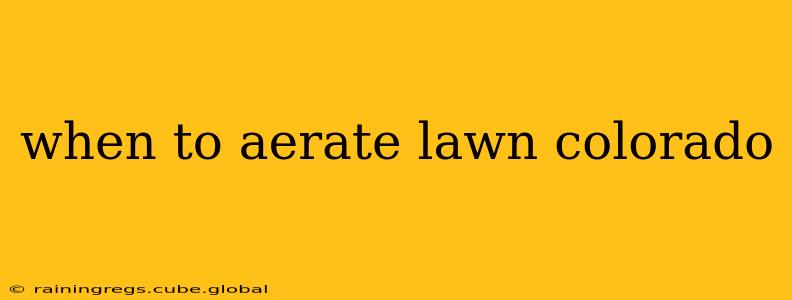Colorado's diverse climate and varied microclimates mean that the ideal time to aerate your lawn isn't a single date on the calendar. Instead, it's determined by several factors, primarily soil conditions and grass type. This guide will help you pinpoint the best time to aerate your Colorado lawn for optimal results.
What is Lawn Aeration?
Before diving into timing, let's clarify what lawn aeration is. It's the process of removing small plugs or cores of soil from your lawn, creating tiny holes that improve air, water, and nutrient penetration. This is crucial for a healthy lawn, particularly in Colorado's often-challenging soil conditions. Compacted soil, a common issue, prevents these essential elements from reaching grass roots, leading to thinning, yellowing, and increased susceptibility to disease.
The Best Time to Aerate in Colorado: Focus on Soil Conditions
The optimal time to aerate in Colorado is spring or fall. However, the specific timing within those seasons depends heavily on your soil. The key is to aerate when the soil is moist but not soggy. Soggy soil will make aeration difficult and ineffective, while dry soil will make it even harder and potentially damage your lawn.
Here's a more detailed breakdown:
Spring Aeration: Aim for late spring after the last frost and when the soil has warmed up sufficiently. This allows for optimal root growth after aeration. Look for consistently warm soil temperatures and slightly damp conditions.
Fall Aeration: Early to mid-fall is another good window. The soil is still warm enough for recovery, and the aeration will help your lawn better withstand winter conditions. Again, check for damp but not overly wet soil.
Avoid Aerating When:
- The soil is frozen: This will damage your equipment and be ineffective.
- The soil is bone dry: This will make aeration difficult and may cause damage.
- It's excessively hot: Extreme heat can stress your lawn, making it less resilient to aeration.
What Type of Grass Do You Have?
Your grass type also plays a role. Colorado lawns commonly include:
- Kentucky bluegrass: Generally benefits from aeration in spring or fall.
- Fescue (fine or tall): Similar to bluegrass, spring or fall aeration is best.
- Zoysia: This warm-season grass is less commonly found at higher altitudes but may benefit from aeration in late spring or early summer.
How Often Should You Aerate Your Lawn in Colorado?
The frequency of aeration depends on several factors including soil type, traffic, and grass type. As a general guideline, most Colorado lawns benefit from aeration every 1-3 years. If you have heavily compacted soil, higher traffic areas, or notice significant thatch build-up, you may need to aerate more frequently.
H2: Does the time of year affect the results of aeration?
Yes, the time of year significantly influences aeration effectiveness. Spring aeration allows for optimal root growth during the growing season, leveraging the improved air, water, and nutrient penetration. Fall aeration helps your lawn recover and withstand winter stress by promoting stronger root systems before dormancy. Conversely, aerating during periods of extreme heat or when the soil is frozen limits benefits and can potentially harm your lawn.
H2: What are the signs that my Colorado lawn needs aeration?
Several signs indicate your Colorado lawn may require aeration:
- Compacted soil: This is often visible as hard, difficult-to-penetrate soil.
- Poor drainage: Water sits on top of the lawn instead of draining away.
- Thatch buildup: A thick layer of organic matter (thatch) between the grass blades and the soil surface.
- Thinning grass: Patches of bare soil or sparse grass growth.
- Poor grass color: Yellowing or browning indicates that the roots are not getting adequate nutrients and water.
H2: What are the best tools for aerating a Colorado lawn?
Several aeration methods exist, catering to different lawn sizes and budgets:
- Core aerators: These remove small plugs of soil, offering the most effective aeration. They are ideal for larger lawns.
- Spike aerators: These create holes but don't remove soil plugs. They are less effective than core aerators but are suitable for smaller lawns.
- Aerating sandals: These are a manual option for smaller areas but are generally less effective than power tools.
Remember, proper lawn care in Colorado requires understanding your specific conditions. By considering these factors and following this guide, you can determine the optimal time to aerate your lawn and enjoy a healthier, lusher landscape.
